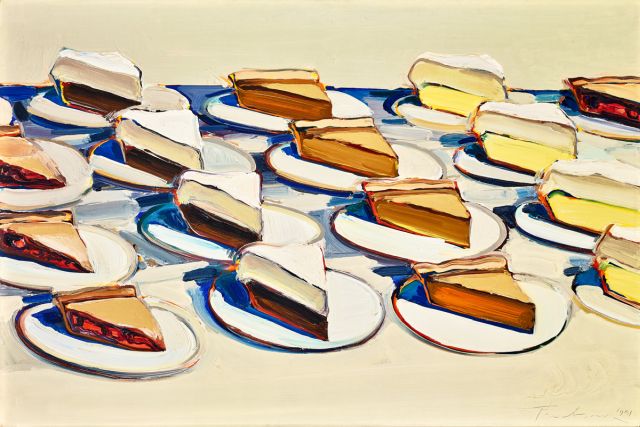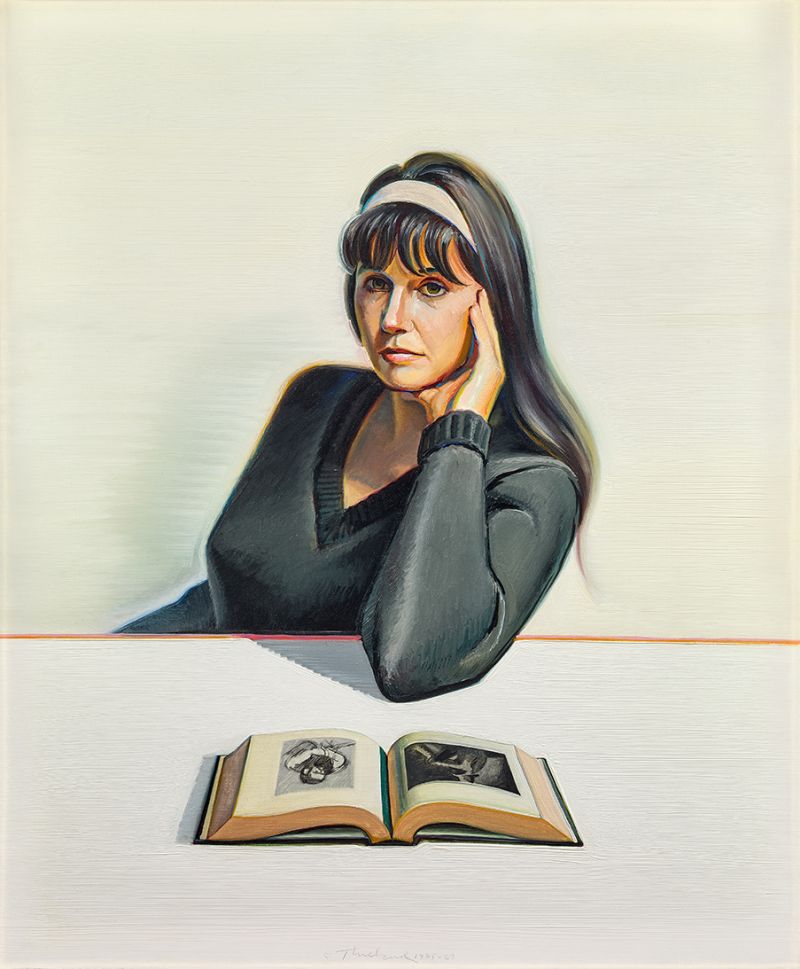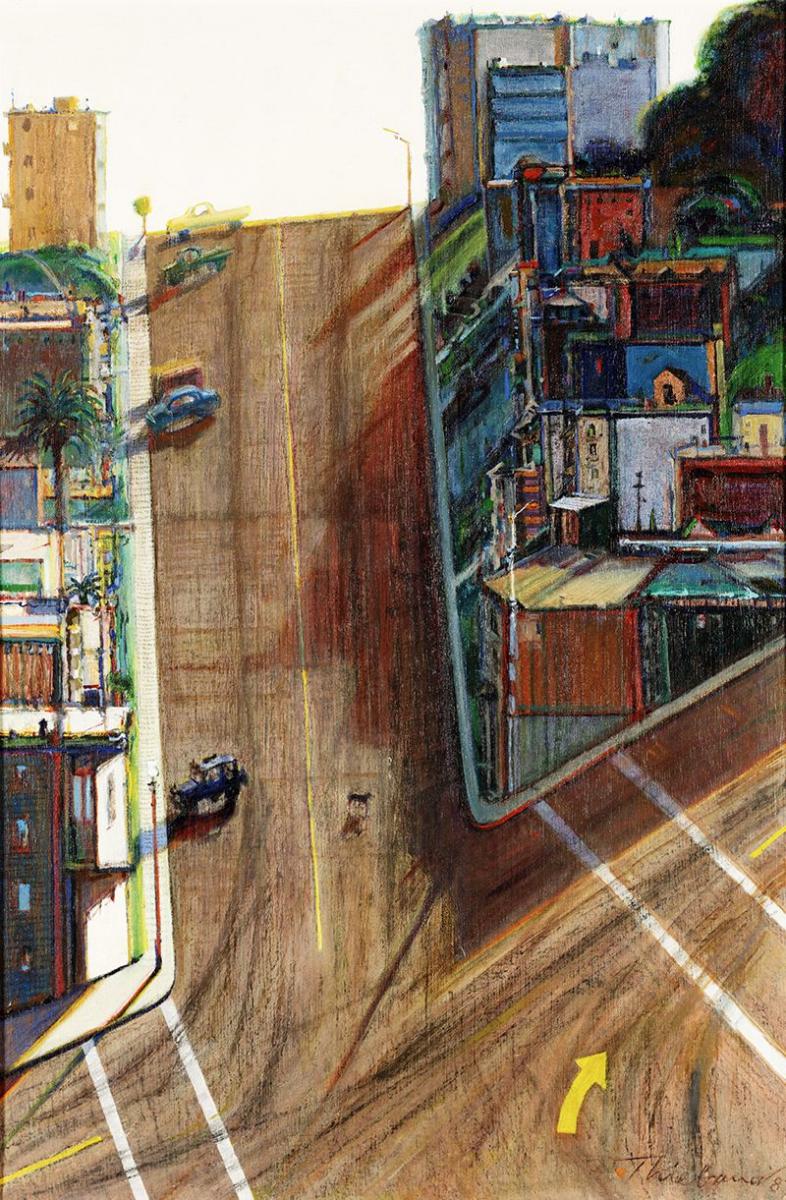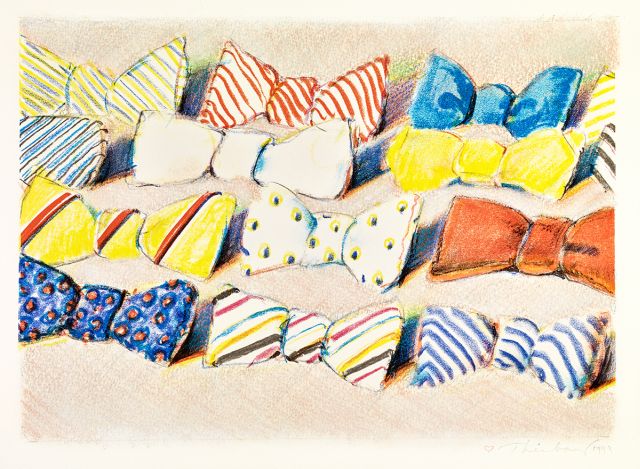
Celebrating 100 Years with 100 Artworks
 |
Walking straight into the Wayne Thiebaud exhibit that recently opened at Sacramento’s Crocker Art Museum brings you to an unusual sight for a Thiebaud show – what appears to be abstract expressionism.
It is, in fact, a seascape, and a closer look reveals what would soon become a signature element for the artist, a horizon line stretching from one side of the canvas to the other.
The painting dates from 1958, a pivotal time in Thiebaud’s career, shortly after he’d seen a major show of Bay Area Figurative artists and shortly before he would emerge with his own distinct look – or, rather, set of looks – that would define his attractive, affecting, often deadpan humorous, and deeply studious work for the remainder of his career.
‘Wayne Thiebaud 100,’ on display to January 3 at the Sacramento museum, celebrates his birthday with an exhibit of 100 paintings, drawings, and prints. Much of the work comes from the artist himself or his family and his foundation; the rest is from the Crocker itself.
 |
The museum notes that it has put on an exhibit of the Sacramento artist’s work every year since 1951. It seems they have had much to work from. Thiebaud can paint quickly; on display is a fine self portrait that he produced in four hours. At age 100, the Crocker tells us, the artist is till painting and still playing tennis.
Thiebaud worked in commercial illustration and sought a career in cartooning before turning to fine art. The lushly painted cakes and pies that brought him success in the early 1960s were not derived from commercial illustration, though.
They began as forms.
“What shall I paint,” Thiebaud asked himself, according to the superb exhibit catalog. He began by working with “basic shapes: a triangle, a rectangle, some square or parallelograms,” Thiebaud said. He looked at one arrangement he had created using triangles and, remembering his days working in restaurants, realized, “I had made basic pies.”
 |
An artist with a deep and lively interest in art history and the art of his contemporaries, Thiebaud has lectured about the art of others often, and has recently spoken to both SacTown Magazine and the San Francisco Chronicle.
In San Francisco, meanwhile, the John Berggruen Gallery has its own exhibit of the artist’s work.
That Thiebaud’s work has been wildly popular with audiences and well-heeled collectors for 60 years now does not speak against it. It is an art of surprising complexity, neither truly Pop Art nor Photo realist.
Thiebaud has never seemed quite so cool as most of the Pop artists, not as ironic. And while a Photo realist like Robert Bechtle appreciated the look and feel of paint, the look and feel of paint is at the core of Thiebaud’s work.
As the wall panels point out, Thiebaud’s paint often mimicks the object it depicts -- icing on cake, meringue in a pie.
His work is all about the push and pull between the objects on canvas and the materials of the painting.
 |
Take a look at the backgrounds of his paintings, the space around the objects. The backgrounds are painted with striations of paint that coagulate around objects, like mudflows coming to a halt.
And how about the way Thiebaud paints shadows? Check out ‘Yellow Hat’ from 2018, with the shadows more garish than the hat itself. The shadows are like force fields emanating from the objects that cast them.
His still life paintings and figures are quiet, meditative, suggesting pure objects, not real things. Does that lemon-bedecked fish in ‘Buffet’ look appetizing? Are you ever tempted to eat one of his pies? No.
And Thiebaud's figures – he often posed his wife, Betty Jean – couldn’t they occasionally smile? Or do something?
“What I’m interested in, really, is the figure that is about to do something, or has done something, or is doing nothing,” Thiebaud has said.
If you want drama, turn instead to his landscapes, inspired by fascination with the places he has lived or otherwise experienced -- steep Potrero Hill in San Francisco, the Central Valley’s flat Delta. The hills of San Francisco he turns into lushly and colorfully painted danger zones, impossibly steep streets, with streets and buildings seen simultaneously as horizontal and vertical planes.
Thiebaud could even make the flat Delta look vertiginous, in images that play with viewpoint and scale. ‘Y River’ is a joy, Delta waterways and crops seen as an aerial view, except one grove of trees which is viewed head-on.
And you’ve got to love Thiebaud’s clowns, late works showing clowns in heaven, clowns colliding. It makes you wonder what the Crocker will come up with for their 2021 Thiebaud show.
- ‹ previous
- 119 of 677
- next ›



